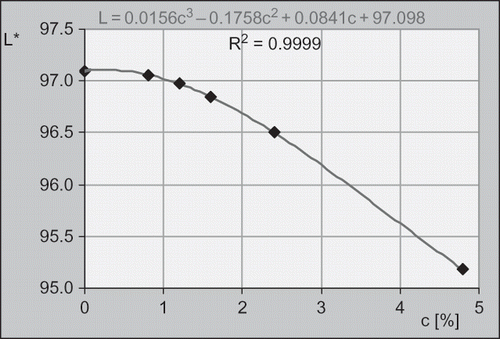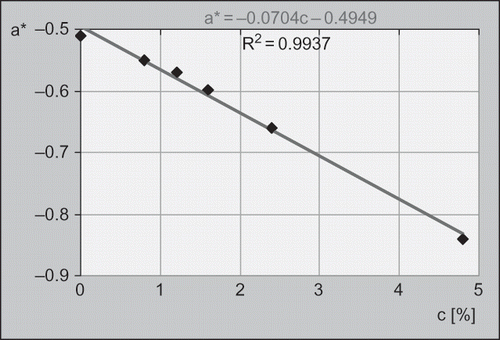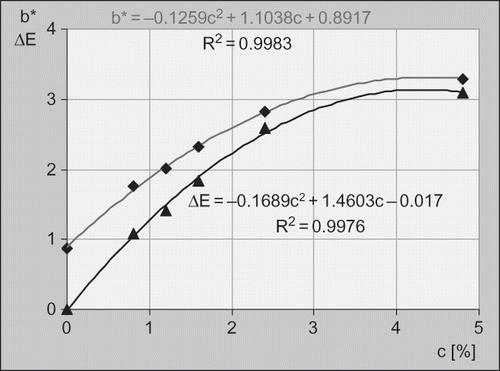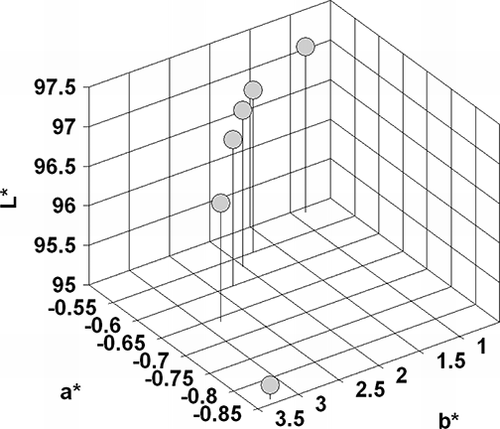Abstract
Colour is one of the major attributes that affect the consumer's perception. This paper presents a study regarding coloring properties of the natural, nontoxic dye extracted from fresh fruits of bilberries (Vaccinum myrtillus). Colours were measured in CIELAB system using a standard white specimen. The samples were different regarding their dye concentration. Experiments comprising more samples sets used three different illuminators. The hue, luminosity, and saturation are discussed. The phenomenon of dichroism was also studied.
Keywords:
INTRODUCTION
Nature is rich in colour and the majority of plant pigments are not widely exploited for the colouring of food. Natural colorants are usually a mixture of dyes whose chemistry is often not precisely defined. In contrast to the dye chemist, who aims to synthesize chemically stable molecules, plants seem to have developed other strategies to protect their colours. The natural dyes are mainly used for colouring foodstuffs and cosmetics. An interesting class of dyes is the anthocyanins, particularly in the blue and red area.[Citation1] Further dyes of this type, especially in the blue to black area, can be found chiefly in elder and dwarf elderberries, bilberries, blackberries, black currants, grapes, bird cherries and in the fruits of the blackthorn and privet. The dyes physically extracted from the edible fruits are approved for food coloration in the EU.
The recent concern over the safety of using synthetic dyes in food industry has encouraged the development and application of natural colorants. The natural colorants are considered safer than the synthetic dyes since they are produced by edible plants. The current consumer preference for naturally derived colorants is associated with their image of being healthy and of good quality. Producers of confectionery, soft drinks, alcoholic beverages, salad dressings and diary products are the most significant users of natural colorants.[Citation2,Citation3] The demand for natural colorants is expected to continue. Bilberry (Vaccinum myrtillus fruits) contains a natural, nontoxic dye. The extraction of such a dye and its use as coloring additive for different food products are subject of intensive research.[Citation4–12]
Color may be described using more color systems such as XYZ, RGB, CMYK, CIELAB, which quantify in different manners the three attributes of color perception: hue, saturation and luminosity.[Citation13–22] CIELAB measurements showed that color intensity is an ambiguous term for the description of anthocyanin colors, since it indistinctly covered simultaneous or alternate variations of two attributes of color, lightness and chroma, which are differently influential in the appreciation of products colors. Generally, variations of the saturation level are producing more attractive effects than those of lightness on the consumer's eye.
The aim of this paper is to describe the coloring power of the anthocyanins pigments from Vaccinium myrtillus fruits. The coloring power shows the relative ability of a pigment to modify the color of another coloring agent to which it is added. For this reason, the colored pigments are observed in mixture with white pigments, usually titanium dioxide, in different ratios. To describe the dye's properties the CIELAB system was chosen. The relationship between surface colour and pigment content was determined using conventional tristimulus colorimetry. The measurements were done after applying the mixture, which contains fruit extract and white pigment onto a cellulosic support. A set of samples, A1 – A5, was analyzed. The samples differ from one another by the concentration of colored pigments quantified by the content of total antocyanins.
MATERIALS AND METHODS
The natural dye was extracted from the bilberry fruits with water at 50°C for 48 hours. The dosage of antocyanins was based on their property of presenting a maximum of absorption at 550 nm in alcoholic and acidic solutions. Detailed description of the extraction and characterization process is available in a different previous work[Citation22]. The dyes extracted from natural fruits were studied considering their colouring properties, especially colouring power. The preparation of the samples (A1–A5) for colour measurement consisted in mixing 2 mL of Vaccinium myrtillus fruit extract with different concentrations (ranging from 0.86·10−3−4.78·10−3 mg anthocyanins/mL extract) in coloured pigments with 20 g white base (titanium dioxide). The content of anthocyanins (coloured pigments) for A1–A5 samples is presented in .
Table 1 The content in antocyanins in the samples submitted for analysis
Colour measurement was carried out in accordance with the CIELAB system. The reference specimen was white. All the values to work with next resulted from measuring with a Minolta 3220d spectrophotometer. To emphasize how essential the reference to a light source is for a correct description of colors, three illuminant conditions were employed for the calculation of color coordinates: illuminant D65 (daylight simulator, colour temperature ∼6500 K), illuminant A (incandescent bulb simulator, colour temperature ∼2856 K), illuminant F2 (cold fluorescent white simulator). The measured parameters were L*:lightness; a*: redness; and b*: yellowness.
RESULTS AND DISCUSSIONS
Five samples labelled A1 to A5 were analyzed. The concentration of coloured pigments in samples decreases from A1 downwards to A5. presents the values of reflectance both for the dye samples and the standard white specimen. Reflectance is a physical measure that depends on the incidence angle, the polarization of the radiation and the refraction index of the materials that form the separation surface. From the data obtained, it can be observed that the reflectance depends on the wavelength and respectively on the colored pigments concentration. The higher the concentration becomes, the stronger the dependence. As for color variation caused by absorbance changes, this study showed that the currently employed term intensity was quite ambiguous indistinctly representing variations of two attributes of color, saturation and lightness. presents the values of the color measurements compared to the white base for the A1–A5 samples for the three illuminants.
Table 2 Spectral reflectance of samples and standard specimen
Table 3 Colour characteristics of the samples
The data presented in show that light sources affect the colour. The seeming change of colour with the light source is a dichroism phenomenon. In food industry the dichroism is, obviously, undesired. The X, Y, and Z tristimulus values (extracted from the transmittance spectral curves) were computerized for a couple of CIE illuminant/observer conditions: D65 (diffuse daylight type), A (tungsten light) and F2 (cold fluorescent white simulator). The CIELAB co-ordinates combining a very high L* (approximately 95 or more) with very low C* (approximately 3 or less) correspond to a virtually achromatic stimulus (i.e., white).
The colouring power of the bilberries extract expressed its relative ability to modify the colour of a white pigment to which the extract is added. The size ΔE* can describe the colouring power. The difference of colour for the bilberries extract, ΔE*, is expressed by the relationship:
Analysis of data presented in allows the following observations: ΔE* influences the colour perception only if its value is higher than 0.5; ΔL* is not very significant since the values of luminosity are very similar for all three illuminants; Δa* is important for the illuminat A (in this case the sample seems more red); Δb* is significant for the illuminat F2 (in this case the sample is more yellow); ΔC* is important for illuminant F2 (in this case the saturation of the colour seems to be stronger); and Δh* is not quite significant since the hues are very similar under all three illuminants.
In most studies, the increase in h* is used as an indicator for the degradation of anthocyanins. Since the Hunter a* and b* parameters represent the redness and respectively the yellowness on the chromaticity dimension, respectively, while the C* and h* parameters represent the combinations of the Hunter a* and b* parameters, the ΔE* represents the total colour change within the white plate. The coordinates L*, a* and b*, specific to CIELAB, vary with the concentration. Figs. illustrate the variation of these coordinates. The coordinate L*, as expected, obeys a descendent line (). At small concentrations, the decrease is slow. One should notice the slope is negative. That means the higher the concentration grows, the darker the colour.
The coordinate a* is negative and quickly decreases linearly (). The presence of the green colour is more obvious as the concentration increases. The coordinate b* is positive and obeys an ascendant parabolic course (). The quantity of yellow is increasing. The colour space L*, a*, b* is represented in .
CONCLUSIONS
CIELAB measurements of samples with different pigments concentrations revealed that colour intensity changes correspondent to simultaneous and extensively variable variations of lightness and chroma. Increasing the absorptivity by increasing the pigment concentration always caused a lower lightness, i.e., their color became darker. Colour measurements of samples containing bilberry fruits extract showed that some measurable spectral variations, especially those recorded at its lowest pigment concentration, did not correspond to a color variation perceptible by the human visual system. Luminosity is quite independent on the nature of the standard light source. F2 and A standard illuminats determine small changes of colour, which shift slightly towards yellow, respectively towards red.
Notes
DIN 6174 Colorimetric evaluation of colour differences of surface colours according to the CIELAB formula.
DIN 53146 Testing of paper and board; determination of opacity DIN 53147 Testing of paper; determination of transparency.
DIN 53236 Prüfung von Farbmitteln; Mess und Auswertebedingungen zur Bestimmung von Farbunterschieden bei Anstrichen, ähnlichen Beschichtungen und Kunststoffen.
DIN 6167 Description of the Yellowing of Near White or Colourless Materials.
REFERENCES
- Freeman , H.S. and Peters , A.T. 2000 . Colorants for Non-Textile Applications , 383 – 415 . Elsevier Science B.V .
- Wissgott , U. and Bortlik , K. 1996 . Prospects for new natural food colorants . Trends in Food Science & Technology , 7 : 298 – 302 .
- Francis , F.J. 1995 . Quality as influenced by color . Food Quality and Preference , 6 : 149 – 155 .
- Szabo , M.R. , Iditoiu , C. , Chambre , D. and Lupea , A.X. 2008 . Antiradical activity evaluation of some plants used in the Romanian cuisine . International Journal of Food Properties , 11 : 330 – 338 .
- Gonnet , J. F. 1998 . Colour effects of co-pigmentation of anthocyanins revisited – 1. A colorimetric definition using the CIELAB scale . Food Chemistry , 63 ( 3 ) : 409 – 415 .
- Giusti , M.M. and Wrolstad , R.E. 2003 . Acylated anthocyanins from edible sources and their applications in food systems . Biochemical Engineering Journal , 14 : 217 – 225 .
- Cooke , D. , Steward , W.P. , Gescher , A. and Marczylo , T. 2005 . Anthocyans from fruits and vegetables – Does bright colour signal cancer chemopreventive activity? . European Journal of Cancer , 41 : 1931 – 1940 .
- Torskangerpoll , K. and Andersen , Ø.M. 2005 . Colour stability of anthocyanins in aqueous solutions at various pH values . Food Chemistry , 89 : 427 – 440 .
- Fossen , T. , Cabrita , L. and Andersen , Ø.M . 1998 . Colour and stability of pure anthocyanins influenced by pH including the alkaline region, Rapid Communication . Food Chemistry , 63 ( 4 ) : 435 – 440 .
- de Pascual-Teresa , S. and Sanchez-Ballesta , M. T. 2007 . Anthocyanins: from plant to health . Phytochem. Rev. ,
- Wrolstsd , R.E. , Durst , R.W. and Lee , J. 2005 . Tracking color and pigment changes in anthocyanin products . Trends in Food Science & Technology , 16 : 423 – 428 .
- Bridle , P. and Timberlake , C.F. 1997 . Anthocyanins as natural food colours – selected aspects . Food Chemistry , 58 ( 1–2 ) : 103 – 109 .
- DIN 6174 Colorimetric evaluation of colour differences of surface colours according to the CIELAB formula.
- Malacarana , D. 2002 . Color vision and colorimetry: theory and applications , Bellingham, WA : SPIE, The International Society for Optical Engineering .
- Collet , S. , Chagas , L. and Baudin , G. 1999 . Colour Management: A User's Point of View, Advances in Printing Science and Technology . Proceedings of the 21st Research Conference of the International Association for the Graphic Arts Industry . September 1999 , Munich.
- Koenig , B. 2003 . Color workbook , Upper Saddle River, NJ : Pearson Education .
- Camgoz , N. 2000 . Effects of hue, saturation, and brightness on attention and preference , Ankara, , Turkey : PhD diss., Bilkent University .
- Berger-Schunn , A. 1994 . Practical Color Measurement , New York : Wiley .
- DIN 53146 Testing of paper and board; determination of opacity DIN 53147 Testing of paper; determination of transparency.
- DIN 53236 Prüfung von Farbmitteln; Mess und Auswertebedingungen zur Bestimmung von Farbunterschieden bei Anstrichen, ähnlichen Beschichtungen und Kunststoffen.
- DIN 6167 Description of the Yellowing of Near White or Colourless Materials.
- Popa , S. , Jurcău , D. , Jurcău , C. and Pleşu , N. 2005 . Pigmenţi organici. Volumul I , Timişoara : Pigmenţii şi culoarea, Ed.Orizonturi Universitare .
- Pop , M. , Lupea , A.X. and Turcuş , V. 2008 . Studies on the polyphenolic compounds extraction from Vaccinium fruits, Revista de chimie . Bucharest , 59 ( 5 ) : 491 – 494 .



